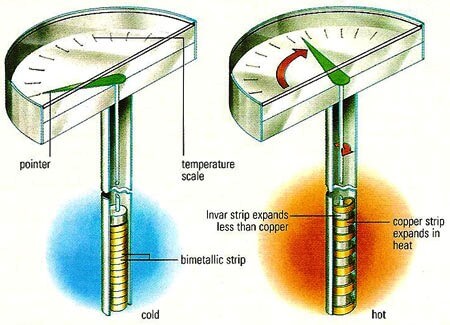Thermometers can be classified according to the nature of substance which expands.
- Expansion of solids
(a). Bimetallic thermometers
- Expansion of liquids
(a) Liquid in glass thermometers
(b) Liquid in metal thermometers
- Expansion of gases:
(a) Gas thermometers.
(a) Bimetallic thermometers:
Principle:
- All metals expand or contract with change in temperature
- The temperature coefficient of expansion is not same for all metals and therefore their rates of expansion or contraction are different
It consists of a bimetallic strip which is constructed by bonding together 2 thin strips of 2 different metals such that they cannot move relative to each other. Bimetallic strip is in the form of a straight cantilever beam. With one end fixed the temperature changes cause the free end to deflect.

The deflection of the free end is directly proportional to the temperature change and square of the length of strip and inversely proportional to the thickness.
(b) Liquid in Glass Thermometers
The filling fluid used here is inert hydrocarbon such as xylene. The thermometer is completely filled with water. The principle used is liquid expansion with an increase of temperature.

A thermometer consists of thermometer bulb, capillary tube, bourdon tube. All are interconnected. The fluids used are methyl alcohol, mercury, and toluene. When we measure it thermometer bulb should be placed inside the fluid.
This change in temperature causes the bourdon tube to expand or contract. The movement of the bourdon tube becomes the measure of temperature
(c) Liquid in metal thermometers:
In this system the bulb is partially filled with liquid, while the capillary and bourdon tubesare filled with vapor. When we measure it thermometer bulb should be placed inside the fluid.
This causes the filling fluid inside the bulb to heat or cool until the temperature matches the temperature of the measured substance. This change in temperature causes the bourdon tube to expand or contract. The movement of the bourdon tube becomes the measure of temperature.
(d) Gas Thermometers
Here a certain amount of inert gases is enclosed in the bulb, capillary and bourdon tube. Due to this the pressure indicated by the bourdon tube may be calibrated in terms of the temperature of the bulb.
The most commonly used gas is nitrogen because of its inexpensive. In certain cases the gas will react with the bulb in such conditions helium will be used.
How to Calibrate a Thermometer?
There are a few different ways to calibrate digital and bi-metal thermometers.
The most common are comparison boiling and freezing. There are also thermometer calibration services who will do this for a price.
Liquid in glass thermometers should be calibrated by a professional.
Note that, if your thermometer does not have an adjusting nut (or calibration screw, etc., usually found on the back of the thermometer), you may have to send it to one of these services for recalibration.
Although you can mark specific temperatures (boiling and freezing points can be marked on thermometer casing with tape) with the following methods, a full range of temperatures may not be achieved.
The first and simplest method is by using comparison. That is, compare the thermometer you believe might need recalibration to a thermometer which has already been calibrated or that has been National Institute of Standards and Technology (NIST) certified. This method can be effective, so long as you are confident that the comparison thermometer is reading correctly, which is why an NIST-Certified thermometer, tested annually, is preferable.
Just compare the two and adjust the thermometer you are calibrating to match the “correct” thermometer’s temperature.
This should be done with distilled water, as tap water has compounds in it which could affect the freezing or melting points of water and skew the process.
Calibration in ice water or “freezing” the thermometer is best for thermometers used to measure low temperatures. Add crushed ice to a bowl or cup of distilled water to form a slushy mix at least 2” deep. Insert the thermometer stem into the slushy mix, for at least one minute. Make sure the stem does not come into contact with the sides or bottom of the container. The thermometer should read between 30° and 34° F. If it doesn’t, adjust the dial 32° F.
To calibrate a thermometer used to measure higher temperatures, you might prefer the boiling method. Again, use distilled water and bring it to a rolling boil in a pot or beaker if you have one handy.
Insert the thermometer’s stem at least 2” into the water for about a minute, taking care not to burn yourself while doing this. Do not let the stem touch the sides or bottom of the container. The thermometer should read between 210° and 214°. If it does not, adjust the dial to 212° F.


